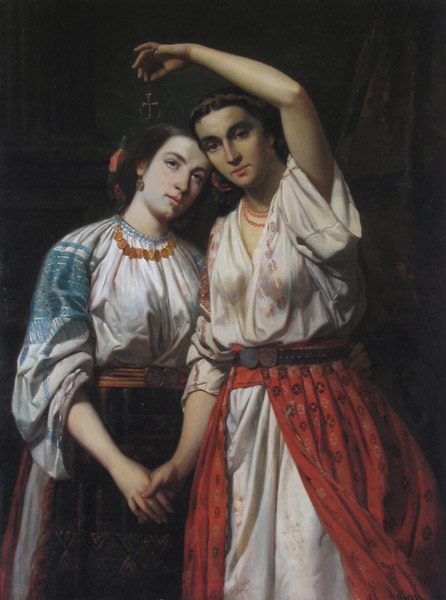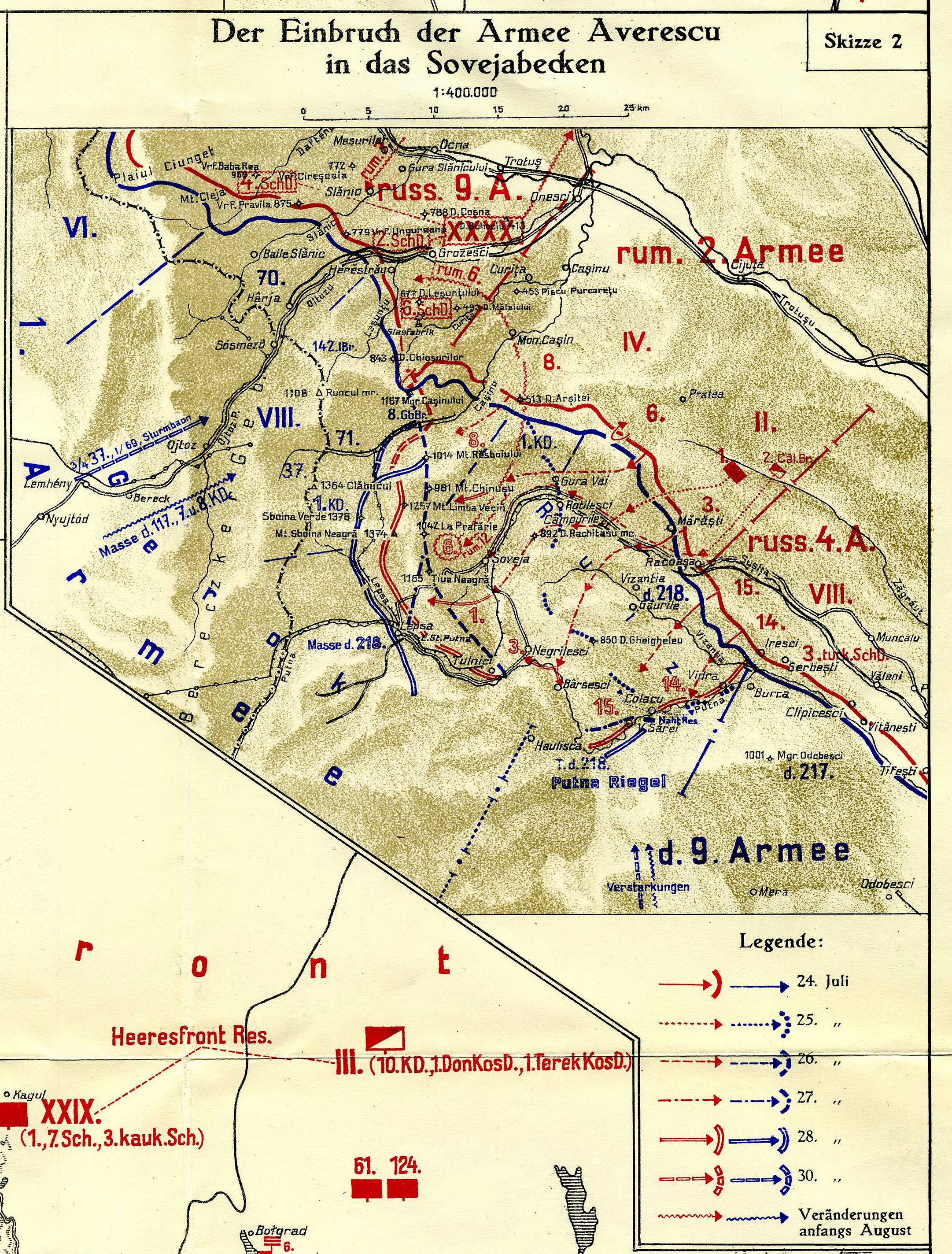|
Battle Of Mărășești
The Battle of Mărășești (6 August 1917 – 3 September 1917) was the last major battle fought by the Central Powers against the Kingdom of Romania and Russian Empire, Russia on the Romania in World War I, Romanian front during World War I. Romania was mostly occupied by the Central Powers, but the Battle of Mărășești kept the northern region of the country free from occupation. Background Mărășești, just like Mărăști, Vrancea, Mărăști, is part of the strategically important area of the Focșani Gate. Control of this area eases attacks into several Romanian regions. On 22 July 1917, the Romanians launched a Kerensky Offensive, joint offensive with Russian Republic, Russia against the Austria-Hungary, Austro-Hungarian 1st Army, around Mărăști and the lower part of the Siret River, Siret river, which resulted in the Battle of Mărăști. Although there was some initial success, a counter-offensive by the Central Powers in Kingdom of Galicia and Lodomeria, Gali ... [...More Info...] [...Related Items...] OR: [Wikipedia] [Google] [Baidu] |
Kingdom Of Romania
The Kingdom of Romania () was a constitutional monarchy that existed from with the crowning of prince Karl of Hohenzollern-Sigmaringen as King of Romania, King Carol I of Romania, Carol I (thus beginning the Romanian royal family), until 1947 with the abdication of King Michael I of Romania, Michael I and the Romanian parliament's proclamation of the Socialist Republic of Romania, Romanian People's Republic. From 1859 to 1877, Romania evolved from a personal union of two Principality, principalities: (Moldavia and Wallachia) called the Unification of Moldavia and Wallachia also known as "The Little Union" under a single prince to an autonomous principality with a House of Hohenzollern, Hohenzollern monarchy. The country gained its independence from the Ottoman Empire during the Russo-Turkish War (1877–1878), 1877–1878 Russo-Turkish War (known locally as the Romanian War of Independence), after which it was forced to cede the southern part of Bessarabia in exchange for Northern ... [...More Info...] [...Related Items...] OR: [Wikipedia] [Google] [Baidu] |
Focșani
Focșani (; ) is the capital city of Vrancea County in Romania on the banks the river Milcov, in the historical region of Moldavia. , it has a population of 66,719. Geography Focșani lies at the foot of the Curvature Carpathians, at a point of convergence for tectonic geologic faults, which raises the risk of earthquakes in the vicinity. Though Vrancea County is one of the most popular wine-producing regions in Romania, Odobești being just to the northwest, in Romania, Focșani itself is not considered a wine-producing center. The wine sold as ''Weisse von Fokshan'' in Germany and some other European countries is generally a ''Fetească Albă de Odobești'' wine, and practically a second-rated wine which does not comply to the European Union rules of naming the regions of origin of wines. The vicinity is rich in minerals such as iron, copper, coal, and petroleum. The city administers two villages, Mândrești-Moldova and Mândrești-Munteni. Focșani lies within the strate ... [...More Info...] [...Related Items...] OR: [Wikipedia] [Google] [Baidu] |
Oituz (river)
The Oituz () is a right tributary of the river Trotuș in Romania Romania is a country located at the crossroads of Central Europe, Central, Eastern Europe, Eastern and Southeast Europe. It borders Ukraine to the north and east, Hungary to the west, Serbia to the southwest, Bulgaria to the south, Moldova to .... It discharges into the Trotuș in Onești. e-calauza.ro The following towns and villages are situated along the river Oituz, from source to mouth: Oituz (CV), Poiana Sărată, Oituz (BC), [...More Info...] [...Related Items...] OR: [Wikipedia] [Google] [Baidu] |
Adjud
Adjud (; ) is a city in Vrancea County, Western Moldavia, Romania. It has a population of 15,178 inhabitants (as of 2021). It lies at a railway junction which has a classification yard and a passenger station. Adjud, situated north of the point where the river Trotuș enters the Siret, used to be a marketplace. The city administers three villages: Adjudu Vechi, Burcioaia, and Șișcani. Geography Adjud is situated on a plain and is surrounded by hills up to a height of at the foot of the Vrancea Mountains, a mountain range in the Curvature Carpathians. The average altitude of the town is above sea level. The surrounding land is favorable for agriculture. Geological research findings show the city's subsoil having layers of gravel and sand Levantine and Quaternary, forming significant hydrological aquifers deposits fed by the Trotuș and Siret rivers and direct rainfalls. The climate is temperate with annual average temperature of 8– and an average rainfall of ... [...More Info...] [...Related Items...] OR: [Wikipedia] [Google] [Baidu] |
Kingdom Of Galicia And Lodomeria
The Kingdom of Galicia and Lodomeria, also known as Austrian Galicia or colloquially Austrian Poland, was a constituent possession of the Habsburg monarchy in the historical region of Galicia (Eastern Europe), Galicia in Eastern Europe. The Crown land#Austria, crown land was established in 1772. The lands were annexed from the Polish-Lithuanian Commonwealth as part of the First Partition of Poland. In 1804 it became a crown land of the newly proclaimed Austrian Empire. From 1867 it was a crown land within the Cisleithanian or Austrian half of the dual monarchy of Austria-Hungary. It maintained a degree of provincial autonomy. Its status remained unchanged until the Dissolution of Austria-Hungary, dissolution of the monarchy in 1918. The domain was initially carved in 1772 from the southwestern part of the Polish–Lithuanian Commonwealth. During the following period, several territorial changes occurred. In 1795 the Habsburg monarchy participated in the Third Partition of Polan ... [...More Info...] [...Related Items...] OR: [Wikipedia] [Google] [Baidu] |
Battle Of Mărăști
The Battle of Mărăști () was one of the main battles to take place on Kingdom of Romania, Romanian soil in World War I. It was fought between 22 July and 1 August 1917, and was an offensive operation of the Romanian Land Forces, Romanian and Military history of Imperial Russia, Russian armies intended to encircle and destroy the German Empire, German 9th Army (German Empire), 9th Army. The operation was planned to occur in tandem with the Nămoloasa offensive; however, this operation was abandoned before it began. According to General Alexandru Averescu, the commander of the Romanian Second Army (Romania), Second Army at this major engagement, the Battle of Mărăști was the "first true victory in the history of the modern Romanian Army". Background Răcoasa, Mărăști, just like Mărășești, is part of the strategically important Focșani Gate, the control of which eases attacks into several Romanian regions. The opposing forces At the beginning of July 1917, based on the ... [...More Info...] [...Related Items...] OR: [Wikipedia] [Google] [Baidu] |
Siret River
The Siret or Sireth (, , , ) is a river that rises from the Carpathians in the Northern Bukovina region of Ukraine, and flows southward into Romania before it joins the Danube. It is long,Planul de management al spațiului hidrografic Siret Administrația Națională Apele Române of which a section is in Romania, and its basin area is , of which in Romania. Its average discharge is . In ancient times, it was named ''Hierasus'' ... [...More Info...] [...Related Items...] OR: [Wikipedia] [Google] [Baidu] |
Austria-Hungary
Austria-Hungary, also referred to as the Austro-Hungarian Empire, the Dual Monarchy or the Habsburg Monarchy, was a multi-national constitutional monarchy in Central Europe#Before World War I, Central Europe between 1867 and 1918. A military and diplomatic alliance, it consisted of two sovereign states with a single monarch who was titled both the Emperor of Austria and the King of Hungary. Austria-Hungary constituted the last phase in the constitutional evolution of the Habsburg monarchy: it was formed with the Austro-Hungarian Compromise of 1867 in the aftermath of the Austro-Prussian War, following wars of independence by Hungary in opposition to Habsburg rule. It was dissolved shortly after Dissolution of Austria-Hungary#Dissolution, Hungary terminated the union with Austria in 1918 at the end of World War 1. One of Europe's major powers, Austria-Hungary was geographically the second-largest country in Europe (after Russian Empire, Russia) and the third-most populous (afte ... [...More Info...] [...Related Items...] OR: [Wikipedia] [Google] [Baidu] |
Russian Republic
The Russian Republic,. referred to as the Russian Democratic Federative Republic in the 1918 Constitution, was a short-lived state which controlled, ''de jure'', the territory of the former Russian Empire after its proclamation by the Russian Provisional Government on 1 September (14 September, ) 1917 in a decree signed by Alexander Kerensky as Minister-Chairman and Alexander Zarudny as Minister of Justice.The Russian Republic Proclaimed at prlib.ru, accessed 12 June 2017 The of the Russian Republic was dissolved after the |
Focșani Gate
The Focșani Gate (; or ) is a militarily and strategically vulnerable area in Romania and NATO. Located in the northeastern part of the Wallachian Plain, it spans an area of east to west and about north to south on the territory of Galați, Vrancea, Buzău, and Brăila counties. Control of the Focșani Gate allows entry into vast tracts of Romanian territory and several other regions of Europe. History The area around the city of Focșani was already recognized as a weak point in Romania back in 1882. In that year, the government of Romania carried out a study to identify all the areas of the country where the terrain was poorly suited for defense, and for engineering work to reinforce these areas. A few years before, Russia, a state then allied to Romania with which it had fought together in the Russo-Turkish War of 1877–1878, had stripped away the region of Southern Bessarabia from Romania, causing tensions between the two countries. Concerns over Romania's defensive ... [...More Info...] [...Related Items...] OR: [Wikipedia] [Google] [Baidu] |





